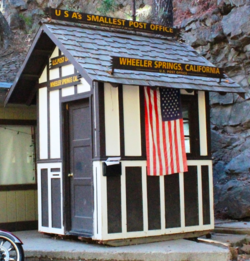Wheeler Springs, California | |
|---|---|
 Wheeler Springs was home to America's smallest post office | |
| Coordinates: 34°30′29″N119°17′29″W / 34.50806°N 119.29139°W | |
| Country | United States |
| State | California |
| County | Ventura |
| Elevation | 1,486 ft (453 m) |
| Population (1980) | |
• Total | 50 |
| Time zone | UTC-8 (Pacific (PST)) |
| • Summer (DST) | UTC-7 (PDT) |
| ZIP Code | 93023 |
| Area code | 805 |
| GNIS feature ID | 254391 [1] |
| Wheeler Hot Springs | |
|---|---|
 | |
| Type | geothermal |
| Discharge | 133 liters/minute |
| Temperature | 39 °C (102 °F) [2] |
Wheeler Springs is an unincorporated community [3] [4] that grew around a set of sulphurated hot springs in Ventura County, California. [5] It is located 6 miles north of the Ojai Valley, within Los Padres National Forest. It is named for Wheeler Blumberg, who founded the town in 1891, [6] and the many natural hot springs. [7]
Contents
- Etymology
- History
- Resort
- Post office
- Geography
- Geology
- Recreation
- Hiking Trails
- References
- Reference bibliography
Wheeler Springs is most known for its former resort, natural hot springs and for previously being home to the smallest post office in the U.S. It is also where TV personality Art Linkletter opened the theme park Kiddyland Park. [6] Wheeler Springs is home to numerous campgrounds, including Wheeler Gorge Campground by Matilija Creek, as well as multiple hiking trails and open-space nature areas.





